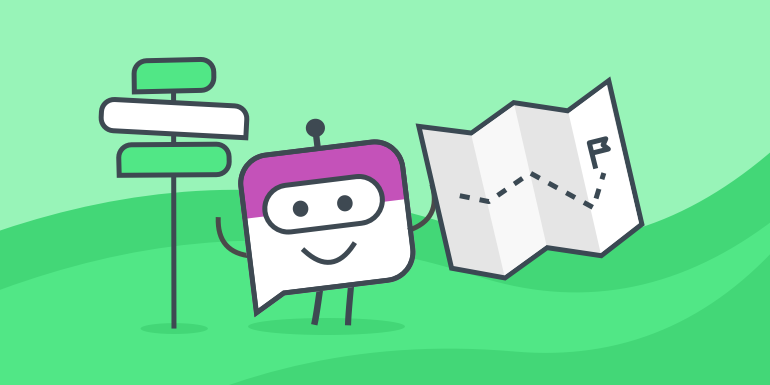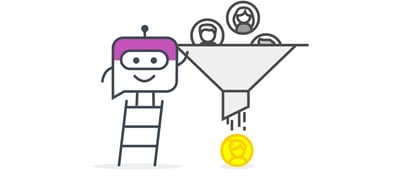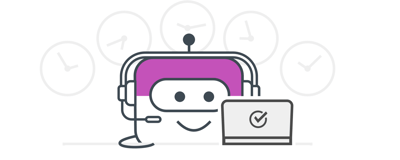5 min read
Chatbot design
Alison Mellon
June 29, 2021

Mapping your customer journey
A customer journey is the entire path a prospective customer follows as they interact with your business.
I’m sure you’ve heard businesses talk about sales funnels or flywheels. To us, that feels a bit like looking through the wrong end of a telescope. If you’re serious about your customers and accelerating leads, you need to take a more customer-centric approach. To do this, you need to understand, and then focus on the customer’s journey.
There are five ways to describe customers through various stages of their journey.
- Strangers
- Visitors
- Leads
- Customers
- Promoters
1. Strangers
Strangers are potential customers but you don’t know exactly who they are. What’s more is that they may not know that you exist. You need to come up with a strategy for attracting strangers to your website. Think about the different ways you could make them aware of your products or services.
2. Visitors
Visitors have found their way to your website, but they still have some questions about who you are. They don’t know much about you yet, but here’s a perfect opportunity for them to discover more. How do you arouse their interest and convert them into someone who wants to learn more about your business?
3. Leads
Leads have taken some kind of action on your website. They have shown an interest in what you have to offer. That doesn’t mean that your products or services are a good fit for their needs. It also doesn’t mean they are a perfect customer for your business. Think about how you can capture and qualify them as a good engagement opportunity for your team.
4. Customers
Customers are the people who pay for your products or services. (Note: they may be different from the people that actually use them). Your team needs to engage with and nurture leads until they can close the opportunity. How does someone move from your lead to your customer?
5. Promoters
Promoters are the customers that you’re really looking for. They’re delighted to use your products or services. They will spontaneously recommend you to friends and colleagues. How do you convert average customers into promoters? Think about compelling experiences that would make customers want to share your business.

Speed to lead
How can you accelerate your leads through the customer journey?
There are some businesses who define “speed to lead” as the time between a website visitor submitting a form and when your team gets back to them. That’s a very narrow definition and it misses out critical parts of a buyer’s journey.
True “speed to lead” is the time between a new visitor arriving on your website and when they engage with your team through a call or meeting. At that point a lead can make an informed decision about becoming a customer.

What is lead acceleration?
Lead acceleration is a growth strategy that aligns and streamlines your inbound sales and marketing activities. It is a customer-centric approach that makes each customer’s journey as personal and friction-free as possible.
There’s a clock that starts ticking the moment a new visitor lands on your website. Once they arrive, are they greeted with personalized content relevant to their needs? Or do they see a generic website? Are there clear calls-to-action? Or are there lots of distractions? Is it simple for them to quickly progress through their journey with your business? Or do they have to wait to be contacted by your team?
The experience starts the moment a new visitor arrives on your website. It begins much sooner than when they sign up for your products or services. Creating seamless, thoughtful customer experiences throughout the journey takes time.
These days, technology has a big part to play in the customer journey. This has changed the way customers think and feel. They expect instant responses to their questions. They look for personalization at various stages of their journey. With scarce time and resources, being available to your customers 24/7 can be difficult. Automation is important.

What should a chatbot user journey look like?
Website chatbots can automate repetitive tasks, allowing your team to focus on more important business.
Website chatbots can be implemented on your website to:
- Engage visitors
- Retain leads
- Collect data
- Increase conversion
- Identify customer needs and improvements
- Turn customers into promoters
Before setting up bots on your website, it’s important to define your customer journey goals and opportunities.
1. Study the stages of your customer journey
Understand where the opportunities are for engagement, data capture, and conversion.
2. Personalize bots to specific audiences and pages
Apply different messaging based on the requirements of the audience targeted, or of the website page they are on.
3. Test, monitor, and adapt
Continuously adapt your bots to your customers’ changing needs and wants.
 The customer journey doesn’t need to be complicated. Lead acceleration is simple with tools such as no-code website chatbots. As a business who is serious about lead acceleration through the customer journey, it’s time to take a customer-centric approach.
The customer journey doesn’t need to be complicated. Lead acceleration is simple with tools such as no-code website chatbots. As a business who is serious about lead acceleration through the customer journey, it’s time to take a customer-centric approach.
ChatOnce has over 70 templates to guide your chatbot implementation. These are ideal for getting started quickly or when you want to create custom bots for landing pages. Why not try one now?
